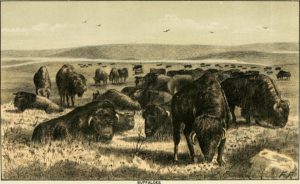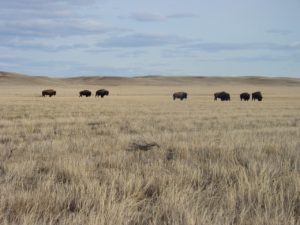The story of bison (Bison bison) conservation is usually told from the United States perspective, but a Canadian version closely parallels the U.S. experience.
The bison was once the most abundant large herbivore of the North American continent, with vast herds of 30-60 million animals living from the Gulf of Mexico to northern Canada. As humans settled the lands, converting forests and prairies to farmlands and towns, they exterminated bison populations. The grasslands of the Great Plains, in the U.S. and Canada, remained the last available habitat for bison.
Bison played an important ecological role in those grasslands. They grazed the vegetation as they roamed over large areas. Dispersing seeds as they went, bison continually renewed the floral community. A diverse faunal community thrived in the grasslands, with hundreds of bird species and dozens of small mammals.

But the Great Plains proved no impediment to the onslaught of human settlement. Enabled by a growing network of railroads, cattle ranchers drove out bison herds and farming uprooted the sod. Ruthless hunters shot every animal they could, shipping enormous quantities of hides and bones to booming east-coast markets. Soon, bison were nearly gone, reduced to a few hundred individuals in isolated herds. By 1881, Canada considered bison extirpated.
The folly of bison mis-management, however, was soon replaced by efforts at restoration. In 1907, Canada established a pure bison herd of about 700 animamls at Elk Island National Park, near Edmonton, Alberta. That herd has been the source for bison reintroduction since then, not only in Canada, but also around the world.
Grasslands National Park was a “natural” for bison reintroduction. The park is in southern Saskatchewan, just north of the international border with Montana. The park ecosystem is a short-grass prairie, subject to strong winds, harsh and variable climate, and long periods of drought, and with vegetation historically maintained by large herbivores—namely prairie bison.
The reintroduction project began in December, 2005, when 71 animals were translocated from Elk Island to Grasslands. They were kept in a 40-acre enclosure for the winter, to allow the animals to acclimate to their new home. On May 24, 2006, the bison were released to roam freely in the park’s 70-square-mile West Block. For the first time in 120 years, bison had rejoined the natural ecosystem.

The herd has thrived. In 2015, it was thinned and now numbers over 300 adult animals. Parks Canada has followed the successful Grasslands reintroduction with a similar project in Banff National Park. Sixteen bison were translocated to Banff from Elk Island in 1917, where they are being held for release into the wild during later 2018. Bison populations now exist at seven Canadian national parks, including both subspecies of plains and wood bison.
The IUCN classifies the bison as a “near-threatened” species, as populations are still low, many are hybrids with cattle, and many carry chronic diseases. Wild, disease-free populations exist only in a few protected conservation areas and number fewer than 5,000 individuals. Despite these ongoing worries, however, like so many wildlife species that had been nearly gone a century ago, the bison is on the way back—in the U.S. and Canada.
References:
Defenders of Wildlife. Basic Facts About Bison. Available at: https://defenders.org/bison/basic-facts. Accessed May 23, 2018.
Parks Canada. 2017. Bison Reintroduction. Available at: https://www.canada.ca/en/parks-canada/news/2017/02/bison_reintroduction.html. Accessed May 23, 2018.
Parks Canada. Grasslands National Park Bison update. Available at: https://www.pc.gc.ca/en/pn-np/sk/grasslands/visit/visit7. Accessed May 23, 2018.
